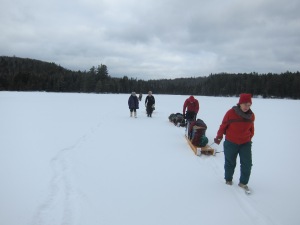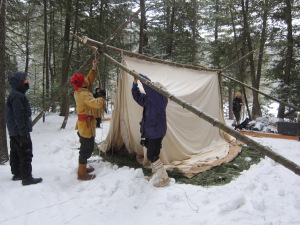I was a starry-eyed bride when I first moved to the boonies with my groom. It was late fall and all the summer people had left long ago. No one else lived within a radius of three kilometers and beyond that was a hermit. The two big social events of the week were the long snowshoe into town to get mail and supplies and to warm up by the pot-bellied stove at Robinson’s General Store, and again, to go to church on Sunday .
Back then, a special cultural event was to have people over for dinner. It was a big operation to get them in our roller-coaster road in winter. Once they were there, the guests could never fully relax, either because they were so anxious about getting out again, especially if it was snowing, or because our cabin was uninsulated and the temperatures outside fluctuated between -30 and -40 C. The poor souls rarely took their coats off throughout the meal or afterward. In any case, besides entertaining, a cultural event was also a day-long snowshoe, a bonfire and picnic in the snow, or stargazing on our backs in the middle of the frozen lake while the wolves howled around us.
Now, thirty years later, I am attending the 9’th annual wine and cheese cultural event of our hamlet. My, how things have changed in Dorset since the 80’s. While we sip our fruit wine, and look at original art of local artists (Yes, I am here with my paintings.), local saxophone musicians, singers, poets, and writers entertain us. It’s all so smooth and urbane. I close my eyes to see if I can fool myself into thinking that I am really in downtown Toronto. It actually works for a few seconds. When I pop my eyes open again, I am happy to find myself sitting in the same old Dorset Rec Centre gym, beside Joanne again. Only now she’s all dressed up. Quite a transformation from this morning when we were here in our sweats doing downward dog side by side in the same spot.
I like the overlap. There’s something real, and homey about bumping into each other over and over again in different contexts. Joanne’s also in my book club, my tai chi class, and my church. We can never become too proud or sophisticated or cultured because we have all seen each other in the undignified happy baby yoga pose and we know each others problems and have prayed together over them in church.
While I still love the old cultural events that connect me to the land and to a simpler way of life in the bush, I enjoy the new, too, especially in my own little hamlet. I learn a lot. I am reminded that Joe, who works with me in the community garden, is one fantastic saxophone musician. Tina, whom I only ever see pushing the grocery cart around our general store, can write splendid poetry. I never noticed before what a great speaking voice Mary has until I listen to her as the MC of the whole cultural evening. She’s always quietly selling tickets for the Concert Association of Huntsville.
It’s an manageable drive to Toronto to see the Picasso art exhibit, or to hear Yo Yo Ma play cello or Margaret Atwood speak whenever the need to see the greats presses. We’re not missing out on much. Up on the Canadian shield we give the everyday artists the stage. We cheer them on and watch them evolve. They are real people. Such a tiny hamlet has a lot of artistic talent and we get to have an evening of fun and discover a bit more about our community members at our annual Evening of Wine, Words, Music and Art.



